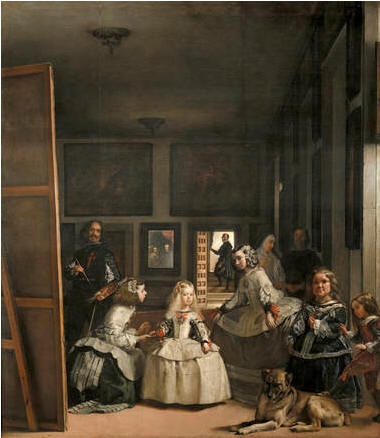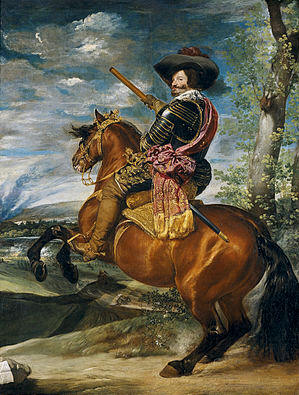

 |
 |
|
| In Madrid's Prado Museum can be found this most famous of works by Diego Rodriguez de Silva y Velazquez which is a portrait of the Infanta Margarita, daughter of Philip IV (1605-1665), surrounded by her servants in a hall of Madrid’s Alcázar Palace. It offers a complex composition built with admirable skill in the use of perspective, the depiction of light, and the representation of atmosphere. | The Count-Duke d'Olivares on horseback painted by Diego Rodriguez de Silva y Velazquez in 1634. The painting hangs in the Prado Museum, Madrid. Olivares was the powerful chief minister of Philip IV who was King during 1621-65. In the 1626-40 period there was an influx of wealthy Portuguese New Christian merchants participating in royal financing organised by Olivares, but when Olivares fell in 1643, they came under the scrutiny of the now unfettered Spanish Inquisition, which he had essentially held at bay. The succession of Portugal in 1640 was a black mark for D'Olivares, and a turning point, for Spanish / Dutch trading relations then improved but Portuguese / Dutch relations became worse, while English / Portuguese relations improved. The transfer of wealth to Amsterdam with the hundred or so Portuguese New Christian families who materialised there was a bitter pill which Spain had to swallow. |
At the end of the Olivares financing (ref 23) there was an exodus of wealthy New Christians, some of whom had run into trouble before the Spanish Inquisition. Many went to Amsterdam either directly, or via Venice, Livorno or otherwise. One of the wealthy merchants to leave was Tomas Rodrigues Pereira who emerged as Abraham Israel Pereira in Amsterdam in 1645, who amongst other things was well known for financing sugar refineries and Jewish philanthropic causes. His family was from Villaflor in Portugal - a town in northern Portugal situated between Braganza, Mogadouro, Lamego and Lousada (see map). He was born there in 1606 and his family was in Madrid by 1610 (ref 145) where he was married in 1628. He died in Amsterdam in 1674 (ref 144). Interestingly, Pereira with a great fortune - by some reports the property of the Spanish crown - made good his escape from Madrid to Amsterdam via Venice (see ref 140).
From ref 123 (pp232-6, 238, 264) we learn about another departing wealthy New Christian Fernando Montezinos. His father was imprisoned by the Coimbra Inquisition (ref 153). In 1654 Montezinos had been in charge of the salt revenue of Galicia and Asturias, and provisioning the garrison of Ceuta. Montezinos was a Madrid agent or correspondent for the Rodrigues Lamegos of Rouen (ref 123 p256), but after trouble with the Cuenca Inquisition in 1656, managed to escape to Antwerp and was able to transfer wealth to Amsterdam with the help of Abraham Israel Pereira. Though Fernando died in 1659 as a nominal Christian in Antwerp, probably thereby protecting the vast Castilian business of his sons Manuel and Bartolome in Seville, his remains were secretly exhumed and he was buried at the Oudekerk Sephardic cemetery near Amsterdam (ref 123 pp 227, 232-3). He left debts behind not covered by assets.
Pereira also assisted Balthazar and Gaspar Rodrigues Cardozo escape with their fortune from Madrid between 1647 and 1655 (ref 123 p232&5).
The Baruch Lousadas had reached Madrid by 1638 when Isaac Baruch Lousada #44 took his 2nd wife, a younger half-sister of the mother of Tomas Rodrigues Pereira. Isaac by 1640 reached Livorno and his nephew Moses by 1649 was in France (possibly Rouen). The 1656 will of Antonio a grandson of Amador de Lousada can be found in the Madrid Historical Archives (ref 145 protocole 9081). The 1677 Amsterdam marriage marriage of David Baruch Louzada #44 to Rachel Levi Gomes who was born in Madrid in 1652 - her brother Jacob was born there in 1658 - provides another strong connection to Madrid; his 1673 Amsterdam marriage to Esther Rodrigues da Costa may also represent a Madrid link (Diogo Rodrigues da Costa was a lender and tax farmer in Madrid from 1635 - see p108 ref 23) though Esther was born in Paris in 1649.